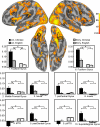Language differences in the brain network for reading in naturalistic story reading and lexical decision
- PMID: 26017384
- PMCID: PMC4446262
- DOI: 10.1371/journal.pone.0124388
Language differences in the brain network for reading in naturalistic story reading and lexical decision
Abstract
Differences in how writing systems represent language raise important questions about whether there could be a universal functional architecture for reading across languages. In order to study potential language differences in the neural networks that support reading skill, we collected fMRI data from readers of alphabetic (English) and morpho-syllabic (Chinese) writing systems during two reading tasks. In one, participants read short stories under conditions that approximate natural reading, and in the other, participants decided whether individual stimuli were real words or not. Prior work comparing these two writing systems has overwhelmingly used meta-linguistic tasks, generally supporting the conclusion that the reading system is organized differently for skilled readers of Chinese and English. We observed that language differences in the reading network were greatly dependent on task. In lexical decision, a pattern consistent with prior research was observed in which the Middle Frontal Gyrus (MFG) and right Fusiform Gyrus (rFFG) were more active for Chinese than for English, whereas the posterior temporal sulcus was more active for English than for Chinese. We found a very different pattern of language effects in a naturalistic reading paradigm, during which significant differences were only observed in visual regions not typically considered specific to the reading network, and the middle temporal gyrus, which is thought to be important for direct mapping of orthography to semantics. Indeed, in areas that are often discussed as supporting distinct cognitive or linguistic functions between the two languages, we observed interaction. Specifically, language differences were most pronounced in MFG and rFFG during the lexical decision task, whereas no language differences were observed in these areas during silent reading of text for comprehension.
Conflict of interest statement
Figures




Similar articles
-
Testing for dual brain processing routes in reading: a direct contrast of chinese character and pinyin reading using FMRI.J Cogn Neurosci. 2002 Oct 1;14(7):1088-98. doi: 10.1162/089892902320474535. J Cogn Neurosci. 2002. PMID: 12419131
-
Developmental dyslexia in Chinese and English populations: dissociating the effect of dyslexia from language differences.Brain. 2010 Jun;133(Pt 6):1694-706. doi: 10.1093/brain/awq106. Epub 2010 May 20. Brain. 2010. PMID: 20488886 Free PMC article.
-
How Characters Are Learned Leaves Its Mark on the Neural Substrates of Chinese Reading.eNeuro. 2022 Dec 21;9(6):ENEURO.0111-22.2022. doi: 10.1523/ENEURO.0111-22.2022. Print 2022 Nov-Dec. eNeuro. 2022. PMID: 36635247 Free PMC article.
-
The Functional Neuroanatomy of Developmental Dyslexia Across Languages and Writing Systems.Front Psychol. 2020 Feb 5;11:155. doi: 10.3389/fpsyg.2020.00155. eCollection 2020. Front Psychol. 2020. PMID: 32116951 Free PMC article. Review.
-
A meta-analysis of fMRI studies on Chinese orthographic, phonological, and semantic processing.Neuroimage. 2012 Oct 15;63(1):381-91. doi: 10.1016/j.neuroimage.2012.06.047. Epub 2012 Jul 1. Neuroimage. 2012. PMID: 22759996 Review.
Cited by
-
Educational fMRI: From the Lab to the Classroom.Front Psychol. 2019 Dec 6;10:2769. doi: 10.3389/fpsyg.2019.02769. eCollection 2019. Front Psychol. 2019. PMID: 31866920 Free PMC article. Review.
-
Constraining current neuroanatomical models of reading: the view from Arabic.Brain Struct Funct. 2024 Dec;229(9):2167-2185. doi: 10.1007/s00429-024-02827-y. Epub 2024 Jul 6. Brain Struct Funct. 2024. PMID: 38969935 Review.
-
Universal brain signature of proficient reading: Evidence from four contrasting languages.Proc Natl Acad Sci U S A. 2015 Dec 15;112(50):15510-5. doi: 10.1073/pnas.1509321112. Epub 2015 Nov 30. Proc Natl Acad Sci U S A. 2015. PMID: 26621710 Free PMC article.
-
Neural Mechanisms of Dorsal and Ventral Visual Regions during Text Reading.Front Psychol. 2016 Sep 15;7:1399. doi: 10.3389/fpsyg.2016.01399. eCollection 2016. Front Psychol. 2016. PMID: 27695434 Free PMC article.
-
A meta-analysis of functional magnetic resonance imaging studies of eye movements and visual word reading.Brain Behav. 2017 Apr 4;7(5):e00683. doi: 10.1002/brb3.683. eCollection 2017 May. Brain Behav. 2017. PMID: 28523225 Free PMC article.
References
-
- DeFrancis J. Visible Speech: The Diverse Oneness of Writing Systems. Honolulu, HI: University of Hawaii Press; 1989.
-
- Hansell M. Chinese writing In: Thurgood G, LaPolla RJ, editors. The Sino-Tibetan Languages. London: Routledge; 2003. p. 156–65.
-
- Perfetti CA, Liu Y, Tan LH. The lexical constituency model: some implications of research on Chinese for general theories of reading. Psychological Review. 2005;112(1):43–59. - PubMed
-
- Seidenberg M. Reading in different writing systems: One architecture, multiple solutions In: McCardle P, Ren J, Tzeng O., editors. Dyslexia Across Language: Orthography and the Gene-Brain-Behavior Link: Paul Brooke Publishing; 2011. p. 151–74.
-
- Harm MW, Seidenberg MS. Computing the meanings of words in reading: cooperative division of labor between visual and phonological processes. Psychological Review. 2004;111(3):662–720. - PubMed
Publication types
MeSH terms
Grants and funding
LinkOut - more resources
Full Text Sources
Other Literature Sources

